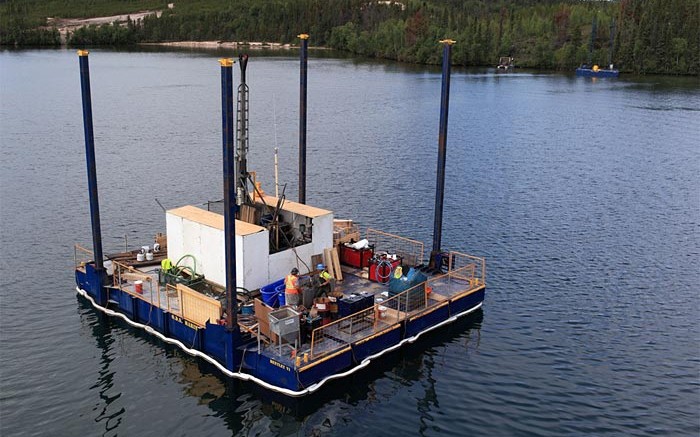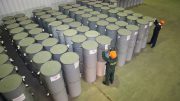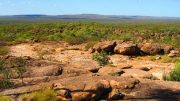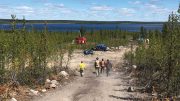VANCOUVER — Fission Uranium (TSX: FCU; US-OTC: FCUUF) is trying to strike a fiscal balance between resource expansion and grassroots discovery at its Patterson Lake South (PLS) uranium project in the Athabasca basin. The company has a good capital position after an $82.2-million investment from China’s state-owned CGN Mining in early 2016, but the depressed state of uranium markets demands a cautious approach to burn rates and project spending.
Fission Uranium is known for its prolific drill campaigns, however, and the weak uranium market didn’t slow activity at PLS too much in 2016.
 Ross McElroy, Fission Uranium president and COO, at the Patterson Lake South uranium project. Credit: Fission Uranium.
Ross McElroy, Fission Uranium president and COO, at the Patterson Lake South uranium project. Credit: Fission Uranium.
The company spent $17 million in its Triple R deposit in 2016, and has lined up a $6.5-million winter program that will include 10,000 metres over 34 drill holes.
Exploration work will follow up on multiple regional targets found in mid-2016, while delineation and expansion work will continue along the 2.6 km Triple R mineralized trend.
“We made the decision late last year that it was time to be more careful and strategic with our money,” Fission Uranium CEO Dev Randhawa says during an interview.
“We’re sticking with the budgets we came up with at the time, but in our conversations with CGN there is an acknowledgement that if we hit something impressive during exploration we can increase spending. Now, if I can raise hard dollars at a share price I think is high enough, we’ll definitely look at that opportunity as well,” he adds.
Fission’s efforts last year focused on adding a pair of new zones to the Triple R trend.
In late 2015, the company’s preliminary economic assessment (PEA) contemplated a $1.1-billion development that would produce 100.8 million lb. U3O8 over a 14-year mine life. The study was underpinned by resources in the central R00E and R780E zones totalling 2 million indicated tonnes grading 1.8% U3O8 for 81.1 million contained lb., and 785,000 inferred tonnes averaging 1.6% U3O8 for 27.3 million contained pounds.
Since the PEA was released, however, Fission has found zones that could increase Triple R’s size.

The field camp at Fission Uranium’s Patterson Lake South uranium project in Saskatchewan. Credit: Fission Uranium.
The R840W zone marks the western edge of the 2.6 km trend, while the R160E zone represents a newly defined eastern boundary.
Fission will dedicate 19 holes of its current program to “growing and connecting the new high-grade zones” that will be added to updated resource estimate and an upcoming prefeasibility study.
Recent assay highlights from R840W include: 11 metres grading 10% uranium from 158 metres deep in hole 16-504; and 9 metres of 6.7% U3O8 from 141 metres deep in hole 16-512.
Meanwhile, Fission reported the “highest-grade mineralization seen to date” in the R1620E zone in October, when hole 16-500 cut 9.5 metres of 13.6% U3O8.

Drillers on a barge at Fission Uranium’s Patterson Lake South uranium project in northern Saskatchewan. Credit: Fission Uranium.
“Last year the two new zones emerged as a positive story for us,” Fission president and chief operating officer Ross McElroy says. “That dovetails well into what we look to accomplish this year, which focuses on expanding the discoveries. Most of the current program will build up the guts of the deposit, which will underpin an economic update in the near-term … the PEA offered us a snapshot, but things are changing at a fast pace.”
Fission plans to drill 15 holes into regional exploration targets, including a 600-metre “hot spot” west of the R840W zone. The target is highlighted by “extremely altered rock” in drill core, and elevated pathfinder geochemistry.
McElroy says the area “strongly resembles Triple R prior to discovery,” and that the company plans on completing two or three follow-up drill holes during the work program.

Fission Uranium’s exploration camp in July 2016 at the Patterson Lake South uranium project in northern Saskatchewan. Photo by Lesley Stokes.
“One thing that helps us stand out from the crowd in the uranium sector is that our mineralization begins 50 metres from surface,” Randhawa says. “And historically it’s the shallow deposits that get mined first. We don’t have water problems associated with the unconformity, which is a point we need to keep hammering home because it comes down to one question: Will the deposit be economic?”
Fission Uranium shares have traded in a 52-week range of 49¢ to 89¢, and gained 19% over the first month of 2016 en route to an 81¢-per-share close at press time. The company had $61 million in cash at the end of November, and has 484.2 million shares outstanding for a $397-million market capitalization at press time.
“CGN is definitely interested in production, but … we’re looking at a seven- to 10-year timeline,” Randhawa says. “We’ll continue to do baseline studies along the way and take all the steps, but our project has been growing so fast it’s hard to commit to a mine plan.”






Be the first to comment on "Fission expands uranium resource at PLS"